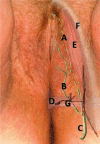Dorsal clitoral nerve injury following transobturator midurethral sling
- PMID: 27729812
- PMCID: PMC5042193
- DOI: 10.2147/JPR.S106150
Dorsal clitoral nerve injury following transobturator midurethral sling
Abstract
Introduction: Transobturator slings can be successfully used to treat stress urinary incontinence and improve quality of life through a minimally invasive vaginal approach. Persistent postoperative pain can occur and pose diagnostic and therapeutic dilemmas. Following a sling procedure, a patient complained of pinching clitoral and perineal pain. Her symptoms of localized clitoral pinching and pain became generalized over the ensuing years, eventually encompassing the entire left vulvovaginal region.
Aim: The aim of this study was to highlight the clinical utility of conventional pain management techniques used for the evaluation and management of patients with postoperative pain following pelvic surgery.
Methods: We described a prototypical patient with persistent pain in and around the clitoral region complicating the clinical course of an otherwise successful sling procedure. We specifically discussed the utility of bedside sensory assessment techniques and selective nerve blocks in the evaluation and management of this prototypical patient.
Results: Neurosensory assessments and a selective nerve block enabled us to trace the source of the patient's pain to nerve entrapment along the dorsal nerve of the clitoris. We then utilized a nerve stimulator-guided hydrodissection technique to release the scar contracture.
Conclusion: This case demonstrates that the dorsal nerve of the clitoris is vulnerable to injury directly and/or indirectly. Assimilation of a time-honored pain management construct for the evaluation and management of patients' pain may improve outcomes while obviating the need for invasive surgery.
Keywords: clitoral pain; complication; nerve entrapment; postoperative pain.
Figures

References
-
- Fisher HW, Lotze PM. Nerve injury locations during retropubic sling procedures. Int Urogynecol J. 2011;22(4):439–441. - PubMed
-
- Nieto ML, Brueseke T, Wu C, Geller E, Zolnoun D. Novel classification of labia anatomy in the evaluation and treatment of vaginal agglutination. Am J Clin Exp Obstet Gynecol. 2016;214(Suppl 4):S515.
-
- Bekker M, Beck J, Putter H, et al. Sexual function improvement following surgery for stress incontinence: the relevance of coital incontinence. J Sex Med. 2009;6(11):3208–3213. - PubMed
-
- Achtari C, McKenzie BJ, Hiscock R, et al. Anatomical study of the obturator foramen and dorsal nerve of the clitoris and their relationship to minimally invasive slings. Int Urogynecol J Pelvic Floor Dysfunct. 2006;17(4):330–334. - PubMed
Publication types
Grants and funding
LinkOut - more resources
Full Text Sources
Other Literature Sources

